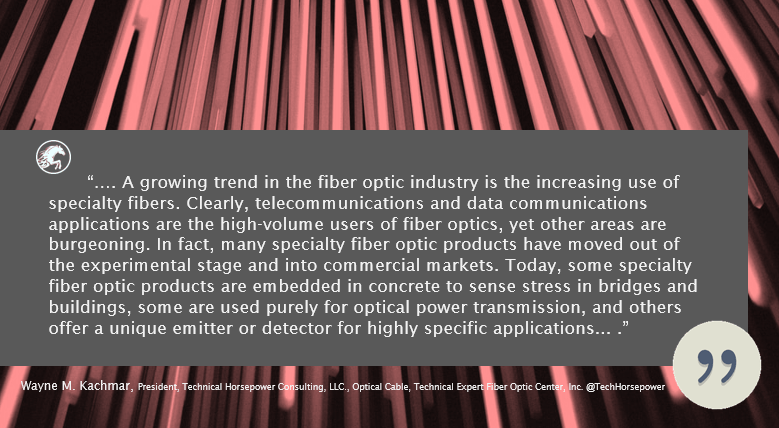In the “dog-eat-dog” world of raw materials, competition is stiff. Margins are tight. Opportunities are rare. Is your company eyeing fiber optics as a new market?
If you’re a raw material supplier looking to sell to the optical cable industry, keep reading.
Here are 4 points to consider – and pitfalls to avoid – to win and retain this new business.
1. Take time to research the market and adjust your material for fiber optic use
The optical cable industry requires extremely specific properties, and you must learn these requirements. For example, let’s look at copper cables:
Several material properties are important to the copper cable industry and center around electrical properties such as insulation resistance, coaxial capacitance, and dielectric constant. Did you know these properties are not relevant to fiber optics? On the other hand, some properties that are not critical to the copper cable industry are ultra-critical to the fiber optic industry such as the thermal coefficient of linear expansion.
In a copper cable, the strength member is often the copper itself. In fiber optics, the glass fiber is certainly not the strength member.
Copper behaves as a thermal stabilizer due to the fact that it is not sensitive to compression or expansion, whereas optical fiber has extreme sensitivity to compression or expansion due to thermal change.
Here’s another consideration: Manufacturers of fiber optic cable assemblies and other components purchase extremely small quantities. Compared to the copper cable industry, very little material is consumed. Keep in mind that fiber optic cables are smaller, lighter, and can have 100X the telecommunications capacity of copper cables.
If you’re a raw material supplier looking to sell to the optical cable industry, you must take time to understand which properties are important to the fiber optic industry (and why), then adjust your material as necessary.
2. Provide expert technical support to your customers from the start. It’s likely they will encounter problems integrating your material into their fiber optic applications
For some industries, raw materials – such as copper cable or polymer – have a fixed set of parameters with little variability. In fiber optics, variability is the name of the game. Your fiber optic customers might have 20 different product designs, each relying on a slightly different property.
Let’s say you’re a raw material supplier of polymer. A new customer tries to implement your polymer in their fiber optic cable assembly production line, but it doesn’t work. Thanks to the amount of variability in this industry, implementation issues are inevitable. Keep in mind, when your customer adds a new component (your material) into their process stream, this can be tumultuous for them – and they may not have the in-house expertise to resolve the issue. Often, they’ll turn to the supplier for guidance and problem resolution. To a great extent, in order to sell a product into this market, you have to manage your customer’s disruptive process change, troubleshoot the issue, and quickly resolve the problem. Think of it this way: You need to manage the customer’s process issue because, effectively, you are creating it!
To ensure the sale doesn’t go dead, you may send your in-house polymer experts to the customer’s facility or, at minimum, hold a conference call. Your in-house experts could know every molecule of the polymer’s makeup. However, if they don’t have a depth of expertise regarding the unique requirements of optical cable – and clearly understand the customer’s production process and specific needs – you will lose the sale.
It’s absolutely critical to have access to knowledgeable technical support from the outset of your customer relationship. This internal or external technical resource should team with your fiber optic customers from the beginning of the relationship, ensuring they can successfully integrate your material into their production line. If you cannot help your customers make your product work, they will turn to another supplier. Without the appropriate technical resource (internal or external), you will be out-competed by a competitor that does provide this expertise.
3. Offer ongoing technical support for customer questions relating to optical cable-specific problems
This time, let’s say you’re a tape manufacturer with water-soluble tape. Your existing customer is experiencing a new problem with the tape interacting with the jacket as well as pinholes in the jacket. Your customer may blame the quality of this particular batch of tape and demand replacement tape.
While most raw material suppliers have in-house technical support, many do not have expertise in troubleshooting process issues that are specific to optical cables. A knowledgeable technical resource – someone with expertise in fiber optics – could examine the tape and pinholes, conduct a sectional analysis, ask the customer process questions, and offer suggestions that would improve the customer’s process and resolve the issue. In short, a technical expert on your team (whether internal or external) can prove the tape product is not at fault. As a result, your company helps the customer solve a process issue and preserves that ongoing business relationship.
4. Be the go-to supplier and technical resource for your customers when they have special needs. (Some requests may lead to new product ideas and business opportunities.)
When a customer comes to you with a special request, it’s quite possible that the immediate solution is not in your wheelhouse. For example, your customer may need to build a fiber optic cable assembly that is able to withstand short-term blasts of jet exhaust. (Crazy as it sounds, this was an actual customer request.) The raw material supplier should not simply reply, “Sorry, we can’t support this” or “Try our material and see if it works.” Instead, a great approach is for the supplier’s technical expert to talk at length with the customer and offer ideas for potential solutions. Together, you may find a way to meet the challenge. In this case, the solution lies in supplying a product with a low heat-transfer capability, so the momentary blast of jet exhaust won’t melt it or ignite it.
A highly experienced technical resource can provide ideas about how to address special needs and solve challenging requests. Even if the challenge can’t be met, you have teamed with your customer to brainstorm solutions, you have supported them, and you appear to be an authority in this area.

Finally, special requests can lead to new business opportunities that you can exploit with your other customers. When you demonstrate that you have the depth of technical expertise – internally or externally – your customer will come back to you with new requests. You get the first shot at that new business. As a raw material supplier planning to sell to the optical cable industry, you must take steps to ensure your company will be the go-to supplier and technical resource throughout the life cycle of that customer relationship, including supporting their special needs and challenging requests.



